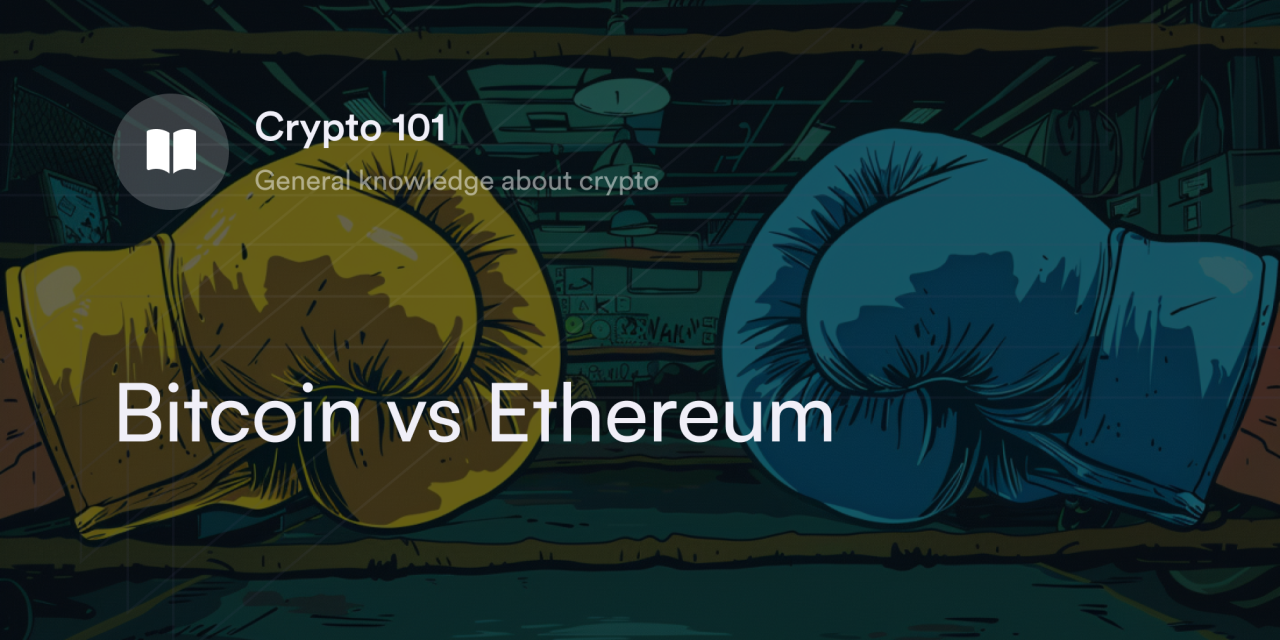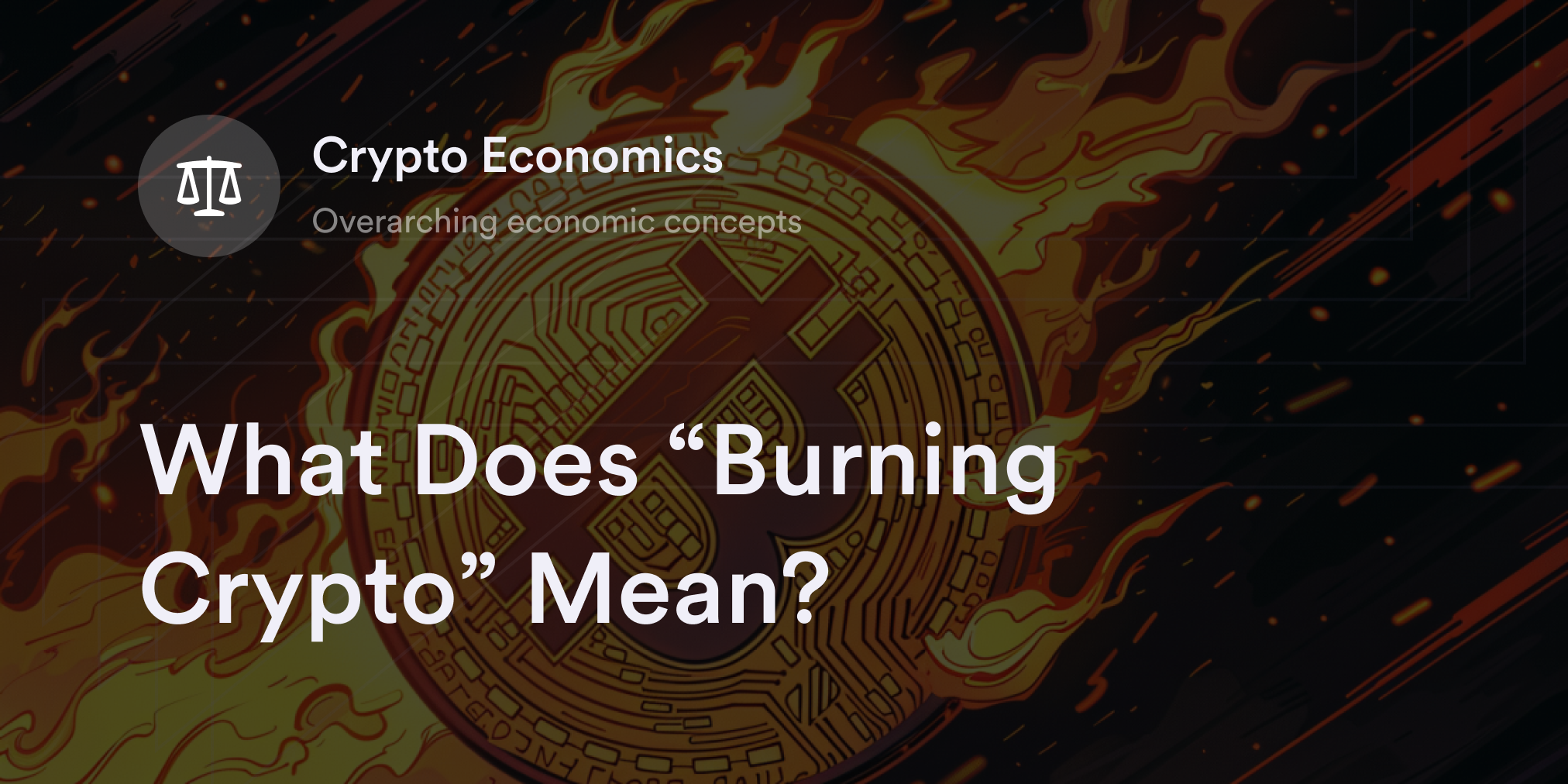


Bitcoin (BTC) and Ethereum (ETH) are leaders in the cryptocurrency market. These digital coins consistently rank as the largest and most influential projects in the blockchain sector. For this reason, few cryptocurrency investors deny the competitive advantages BTC and ETH share, but there remains a heated debate over which asset is “better.”
Although BTC and ETH have similarities, they aren’t in direct competition. Learn more about Bitcoin versus Ethereum and gain a greater appreciation for the diversity of crypto projects.
Bitcoin and Ethereum: Understanding the Basics
From their beginnings, Bitcoin and Ethereum had different goals for blockchain technology. It’s essential for new investors to review each cryptocurrency’s history and learn the context behind their unique features.
What is Bitcoin?
Bitcoin is the oldest and most successful cryptocurrency in terms of market cap. In 2008, the mysterious cryptographer Satoshi Nakamoto envisioned Bitcoin as a global peer-to-peer (P2P) payment platform. Nakamoto used a consensus algorithm called “Proof-of-Work” (PoW) to broadcast, store, and confirm transactions without a central authority. Computers that join the Bitcoin protocol can “mine” new BTC by solving complex mathematical problems every 10 minutes. The first computer to win this mini-math competition receives a BTC reward.
Although Bitcoin still functions as a digital payment network, it now has the status of “digital gold.” Like physical gold, BTC is a scarce and desirable asset with a limited supply of only 21 million coins. For this reason, some investors view Bitcoin as a speculative “store of value” investment, believing it will retain its value over time.
What is Ethereum?
Ethereum is a blockchain project that aims to decentralize the Internet. Even though Ethereum has a native cryptocurrency (the Ether token), its primary goal has never been to replace Bitcoin. Instead, the Ethereum blockchain encourages developers to create decentralized applications (dApps) on top of its protocol with the help of “smart contracts.”
Smart contracts are programs that execute commands without intermediaries. For example, a smart contract could detect when a user deposits collateral into a decentralized crypto lending app like Aave. In this case, smart contracts will automatically send the desired loan to the borrower’s cryptocurrency wallet and monitor the value of the collateral.
Computer programmer Vitalik Buterin introduced Ethereum in 2013 and launched the blockchain two years later. Although Ethereum initially used a PoW consensus mechanism, the development team transitioned to a “Proof-of-Stake” (PoS) network in 2022. PoS networks make validators lock crypto on the blockchain to confirm transactions and receive rewards. To join the Ethereum blockchain, validators must lock at least 32 ETH.
How is Ethereum Different from Bitcoin?
Dozens of features distinguish Ethereum from Bitcoin, but four crucial components put these cryptocurrencies in separate categories. Here are the key distinctions:
Purpose
Although Bitcoin’s revolutionary infrastructure inspired Ethereum’s team, ETH developers didn’t view Ethereum as a “better BTC.” Instead, the Ethereum protocol uses smart contracts to decentralize Web-based services. The Ether cryptocurrency has utility within the Ethereum ecosystem to pay for on-chain transaction fees and access dApps in fields such as decentralized finance (DeFi), play-to-earn gaming, and decentralized social media.
By contrast, Satoshi Nakamoto wanted Bitcoin to become a real-world payment network. Bitcoin supporters believe BTC is a viable alternative to fiat currencies and a potential global reserve currency. While it’s possible to build dApps on top of Bitcoin, Nakamoto’s goal was to use blockchain technology to create a new version of digital cash.
Consensus Mechanism
Between 2015 and 2022, Ethereum and Bitcoin used the same PoW consensus algorithm to confirm transactions. In both systems, “miners” used computing power to solve puzzles, validate blocks of transactions, and earn cryptocurrency rewards.
But in September of 2022, the Ethereum blockchain switched to a PoS system. Now, anyone who wants to process transactions on Ethereum has to lock at least 32 ETH on the blockchain. A PoS algorithm randomly chooses one “staker” to confirm new transactions every few minutes, and ETH validators receive cryptocurrency rewards every time they verify a new batch of transfers.
Environmental Impact
PoW mining is an energy-intensive process. Despite recent reports that Bitcoin’s miners use 59.5% renewables, BTC has a noticeable environmental impact. Researchers at Cambridge University suggest the Bitcoin blockchain currently pollutes over 4.8 million tons of carbon dioxide yearly and produced 200 million tons of carbon dioxide between 2009 and 2022.
When Ethereum was a PoW chain, it was one of the dirtiest cryptocurrencies. However, since transitioning to PoS, the Ethereum Foundation cut its electricity and pollution rates by 99.95%, and the blockchain dropped its carbon dioxide emissions from 11 million to 870 tons annually.
Coin Issuance
Bitcoin has the most predictable issuance schedule in cryptocurrency. To maintain scarcity, the number of Bitcoins that enter circulation drops by half every four years in an event called “the halvening.” This pre-set reward reduction continues until there are 21 million BTC in circulation, and the goal is for Bitcoin to have a 0% inflation rate by the year 2140.
Ethereum’s ETH doesn’t have a hard-cap supply, but that doesn’t mean it’s an inflationary cryptocurrency. Following 2021’s “EIP-1559” upgrade, the Ethereum blockchain burns a percentage of ETH used to pay for fees on its network. “Burning” cryptocurrency means deliberately wiping it out of existence. Whenever ETH’s burn rate rises above the average daily issuance of 1,700 ETH per day, it becomes a deflationary asset.
What Are the Similarities Between Bitcoin and Ethereum?
The dissimilarities between BTC and ETH may be significant, but these cryptocurrencies still have a few commonalities. Here are some examples:
Use of blockchain technology: BTC and ETH don’t use the same consensus mechanisms, but they both rely on decentralized networks of computers. These cryptocurrencies also have open-source code and public ledgers, meaning anyone can join the networks and review transaction history.
Inflation hedge investments: Due to their coin issuance schedules, some investors view both ETH and BTC as store of value assets, similar to gold. BTC’s hard-cap supply and ETH’s burning mechanism make them attractive (albeit speculative) long-term investment ideas.
High liquidity and accessibility: Thanks to their high trading volume, Bitcoin and Ethereum are the most liquid assets in cryptocurrency. In other words, transferring BTC or ETH into cash is simple because of their demand. Traders can easily buy or sell these cryptocurrencies on exchanges or crypto ATMs, and BTC and ETH products are also available on traditional institutions like the Chicago Mercantile Exchange (CME) and New York Stock Exchange (NYSE).
What Is the Ethereum “Flippening?”
The “Flippening” is cryptocurrency slang. It describes the potential event when ETH “flips” BTC and becomes the world’s most valuable cryptocurrency. Ethereum supporters sometimes argue ETH will have more value than BTC as ETH takes over Web3. Although the Flippening is a popular meme in cryptocurrency circles, it’s a highly speculative theory. At current prices, Ethereum would need to double its market capitalization to match BTC’s value.
Choosing Between Bitcoin and Ethereum
It’s impossible to say Bitcoin is “better” than Ethereum, or vice versa. Both coins have unique use cases, features, and goals, making them distinct projects. Buying BTC versus ETH depends on an investor’s intentions and opinions of each cryptocurrency.
Both BTC and ETH have the potential to become digital stores of value assets. However, BTC’s longer history, higher liquidity, and hard-cap supply of 21 million make it a more conservative option. Even though BTC is volatile, its value doesn’t typically fluctuate as much as altcoins like ETH.
On the flip side, most of today’s cutting-edge dApps are on the Ethereum blockchain. Recent estimates suggest Ethereum holds 60% of the total value in the entire DeFi ecosystem. People interested in exploring new fields like DeFi or NFTs (non-fungible tokens) may get more value out of ETH.
The bottom line is that choosing to invest in BTC or ETC is a personal decision. Anyone considering allocating money to Bitcoin or Ethereum should review each project’s major features to see how they align with their financial goals.
Learn More About Cryptocurrencies on dYdX
dYdX offers convenient access to cryptocurrencies derivatives called perpetuals for Bitcoin, Ethereum, and dozens of other crypto assets. For more details on dYdX’s offerings, check out our blog, YouTube channel, decentralized trading platform.
Disclaimer
The content of this article (the “Article”) is provided for general informational purposes only. Reference to any specific strategy, technique, product, service, or entity does not constitute an endorsement or recommendation by dYdX Trading Inc., or any affiliate, agent, or representative thereof (“dYdX”). Use of strategies, techniques, products or services referenced in this Article may involve material risks, including the risk of financial losses arising from the volatility, operational loss, or nonconsensual liquidation of digital assets. The content of this Article does not constitute, and should not be considered, construed, or relied upon as, financial advice, legal advice, tax advice, investment advice, or advice of any other nature; and the content of this Article is not an offer, solicitation or call to action to make any investment, or purchase any crypto asset, of any kind. dYdX makes no representation, assurance or guarantee as to the accuracy, completeness, timeliness, suitability, or validity of any information in this Article or any third-party website that may be linked to it. You are solely responsible for conducting independent research, performing due diligence, and/or seeking advice from a professional advisor prior to taking any financial, tax, legal, or investment action.
You may only use the dYdX Services in compliance with the dYdX Terms of Use available here, including the geographic restrictions therein.
Any applicable sponsorship in connection with this Article will be disclosed, and any reference to a sponsor in this Article is for disclosure purposes, or informational in nature, and in any event is not a call to action to make an investment, acquire a service or product, or purchase crypto assets. This Article does not offer the purchase or sale of any financial instruments or related services.
By accessing this Article and taking any action in connection with the information contained in this Article, you agree that dYdX is not responsible, directly or indirectly, for any errors, omissions, or delays related to this Article, or any damage, injury, or loss incurred in connection with use of or reliance on the content of this Article, including any specific strategy, technique, product, service, or entity that may be referenced in the Article.







